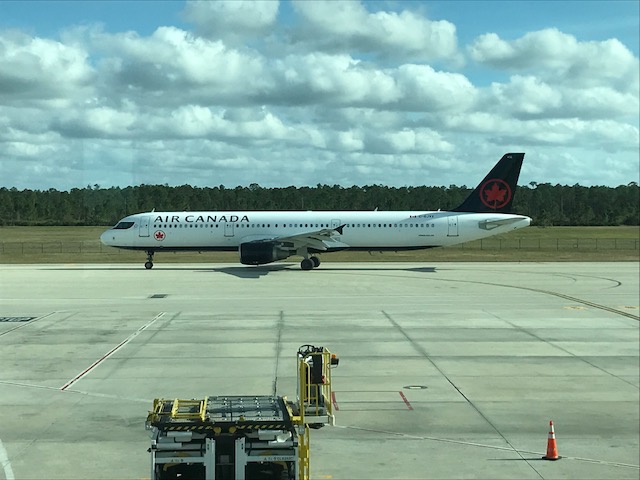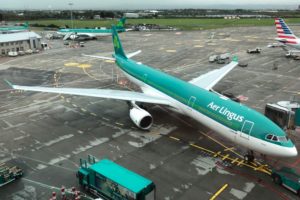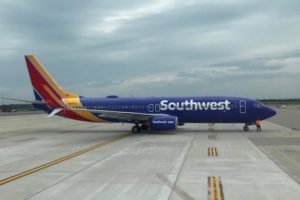Airline Profile: Air Canada
The Facts
| Founded | 1936 |
| Alliance | Star Alliance |
| Hubs | Toronto Pearson International Airport Montreal Pierre Elliott Trudeau International Airport Vancouver International Airport Calgary International Airport |
| Headquarters | Montreal |
| Fleet Count | Around 156 (not including subsidiaries) |
| Skytrax Rating | 4 (out of 5) |
| Subsidiaries | Air Canada Express (regional) Air Canada Jetz (charter) Air Canada Rouge (leisure/low cost) |
| Travel Classes | Economy Class Premium Economy Class Business Class/Signatue Class |
| Frequent Flyer Program | Aeroplan |
| Website | aircanada.com |
| Type of Airline | Full Service Carrier |
| Competitors | WestJet Porter Airlines (select routes) |
| Logo |

Analysis
6 Things To Know About Air Canada
- Fleet: Air Canada’s mainline fleet consists of only Boeing and Airbus aircraft, now that they have retired their E190s from their mainline fleet, due to COVID-19. In terms of their narrow body fleet, their most prominent aircraft type is the A320 series, in which they operate the A319, A320, and A321, though they intend to retire many of their A319s and A320s in the short-term. Additionally, their next-generation short-haul fleet consists of the A220-300s, with plans to increase their A220 sub-fleet to 45, and they also operate a significant fleet of Boeing 737 MAXs, with plans to increase that sub-fleet to 50, though they are obviously all grounded. The backbone of Air Canada’s long-haul fleet is the Boeing 787, of which they operate 37 aircraft (both the -8 and -9 variants). Meanwhile, they additionally operate 25 Boeing 777s (both -200LRs and -300ERs), along with 15 Airbus A330-300s. Air Canada recently retired all of their Boeing 767-300ERs (including those operated by Air Canada Rouge, meaning that they’ll no longer operate long-haul flights), with no replacement in the works, due to likely having to downsize in the long-term due to COVID.
- Hubs: Air Canada’s largest hub is at Toronto Pearson International Airport (despite its headquarters being in Montreal), which is where they (normally would) operate most of their flights to Europe, along with a large portion of their flights to destinations within North America, especially to the US. Air Canada’s second largest (I believe; I could be mistaken, it could be its third) hub is in Montreal, where it also operates a significant amount of flights to the US, along with operating to a large quantity of destinations in Europe, especially to cities in France or to cities with heavy French ties (i.e. Casablanca, Nice, Lyon, Toulouse, Geneva). Air Canada’s largest pacific hub is in Vancouver, where Air Canada operates the vast majority of its transpacific flights and to cities along the west coast in the US. Air Canada’s last “hub”–per se– is at Calgary International Airport, where Air Canada operates a few long-haul flights (such as to London, Frankfurt, and Tokyo), though its hub there cannot compete with WestJet’s Calgary hub. Air Canada also has larger operations (they could be considered as focus cities) at Halifax Airport and at Ottawa Airport, both of which normally would have daily flights to London. Air Canada also normally would have a daily flight to London from St. John’s Airport, though its operations there are not large enough to be considered as a focus city.

- Air Canada Rouge: Air Canada’s main leisure subsidiary is Air Canada Rouge, which was started operations in 2013, mainly to operate flights to leisure destinations and offer a no-frills product in order to bring down prices and compete with airlines such as Sunwing, Air Transit, and WestJet. In addition to their fleet of A320 series aircraft, Air Canada Rouge soon was given ex-Air Canada 767-300ERs, in order to offer higher capacity to North American and Caribbean leisure destinations and to be able to operate long-haul flights to leisure destinations, such as Athens, Lisbon, or Venice. All Air Canada Rouge aircraft (besides a few single cabin A321s) consist of two cabins: economy class (though there are some extra legroom seats) and Premium Rouge, which consists of domestic US first class-esque seats with leg rests. On short-haul flights, Premium Rouge is more of a short-haul business class, while on long-haul flights, it acted more as a premium economy product. Economy class passengers don’t receive items which they would normally get on mainline flights, such as meals or on-demand entertainment (though streaming entertainment is available), and similarly to low-cost carriers, baggage does cost more. However, Premium Rouge passengers do receive free meals, and access to Maple Leaf Lounges is complimentary, though only on flights to the Caribbean and North America (outside of that, it costs money). Due to the COVID-19 pandemic, Air Canada has decided to downsize Air Canada Rouge, with them likely to end all long-haul routes and retire most 767s and operate mostly short-haul leisure flights.
- Air Canada Express: Air Canada Express serves the same purpose as United Express or American Eagle, in that it operates mostly regional flights to smaller feeder airports from its hubs. Two regional airlines operate flights on behalf of Air Canada Express, those two being Jazz Aviation and Sky Regional Airlines. Sky Regional Airlines operates a fleet of 25 Embraer E175s, while Jazz Aviation operates a fleet of De Havilland Dash-8 300s, Dash-8 400s, along with CRJ-200s and CRJ-900s. Much to the consumer’s joy, all Air Canada Express CRJ-900s and E175s have personal on-demand entertainment, making them one of the few airlines to have personal entertainment screens on regional jets.

- Aeroplan: Air Canada has a long history with their frequent flyer program; it used to be fully owned by Air Canada, but a few years ago, Air Canada sold the program, though they recently bought it back. Anyways, since Air Canada just bought it back, there are some major upcoming changes to the program, including changes to status levels, ways to earn miles, credit cards, and how you can use miles. With the changes, Air Canada is implementing what is possibly the world’s most intricate award chart, having divided the world into only four regions, though having charging tickets based on distance as well as region. However, there are some upsides to the changes, such as a very generous stopover policy which only requires an additional 5,000 miles on one-way flights and pretty generous award routing rules, where you don’t necessarily need to have a logical direction of travel.
- Lounges: Air Canada’s main lounge is the Maple Leaf Lounge, which is available at most large airports in Canada, as well as some airports in the US and abroad, such as at LaGuardia or Paris. Customers traveling in business class (short and long haul) on Air Canada or partnering airlines, as well as passengers with select credit cards or status are eligible to enter. Air Canada’s Maple Leaf Lounges are pretty similar to United Clubs or Delta SkyClubs; the generally have a light food and drink selection, though some lounges do have warm meals available and showers. Air Canada also has a special lounge (which I believe has the same access requirements as the Maple Leaf Lounges) called the Air Canada Cafe at the domestic section of Air Canada’s Toronto gates, which has grab and go food and drinks (hence the name, cafe) along with some seating. Air Canada’s flagship lounge is the Signature Suite, located at Toronto and Vancouver Airports (I think there will be a future one in Montreal) available exclusively to passengers traveling to Europe, South America, Asia, and Australia in Air Canada’s Signature Class traveling in J, C, D, Z, P booking classes (no award tickets are allowed). The lounges’ main feature are their dining areas, where they have both a warm buffet section and a fairly large sit down restaurant, which is known to have possibly the best food at a business class lounge in the world. Besides the food, though, the lounges are pretty unremarkable, with only basic seating available.

Travel Classes:
Economy: Economy class is in a 2-2 configurations onboard all Air Canada Express Aircraft, a 2-3 configuration onboard all A220s, a 3-3 configuration onboard all 737s and A320 series aircraft, a 2-3-2 configuration onboard all 767s (though most are being retired now), a 2-4-2 configuration onboard all A330s, a 3-3-3 configuration onboard all 787s, and a 3-4-3 configuration onboard all 777s. Personal on-demand entertainment is available onboard all mainline aircraft, along with all E175s and CRJ-900s via Air Canada’s EnRoute IFE System, which I would say is quite an impressive feat, especially since they are the only airline within North America to have achieved that. On flights within North America and the Caribbean, hot meals are available for purchase on most type of aircraft. On long-haul flights, Air Canada provides free hot meals in economy and ms available for purchase via duty-free.

On all aircraft, Air Canada offers a section of economy labeled as preferred seating. With a surcharge (from $17-$299), passengers receive extra legroom and priority boarding. It is comparable to United’s Economy Plus or American’s Main Cabin Extra. Prices for checked baggage varies depending on which travel class you are traveling in. Use this calculator from Air Canada to determine how much checked baggage will cost for you.
Premium Economy
Premium Economy is in available on all long-haul aircraft and is in a 2-3-2 configuration on all A330s and 787s and is in a 2-4-2 configuration onboard all 777s. Air Canada has a uniform seat onboard all of their long-haul aircraft, which is relatively standard, as long as premium economy seats go. Each seat has more legroom than in economy class (38 inches), has more seat width (18-20 inches), and also has more recline. Additionally, seats also have foot rests, though they don’t have leg rests which extend out of the seat, which really only makes a difference for shorter passengers.

All seats also are equipped with USB ports and power outlets. Passengers also do get priority boarding, check-in, and priority baggage handling. On long-haul flights, passengers receive premium meals which generally are between economy class and business class in terms of quality, while passengers only get a meal box on intra North American flights.
Business Class:
Air Canada labels its intra-North American premium cabin product simply as Business Class, which is available on all two-cabin aircraft. However, on some routes operated by wide-body aircraft, Air Canada brands its business class cabin as Signature Class, like it does on its long-haul flights (see next section for more details); in other words, business class is available on all of its short-haul flights operated by narrow-body (and some regional) jets.

Air Canada (generally) has two different seats which it uses in its short-haul business class product. The former is available on its Airbus A320 series aircraft, as well as on its E175s and CRJ900s (though the seats on the latter two aircraft are slightly different). The seats are in a 2-2 configuration on their A320s and are in a 1-2 configuration on their E175s and CRJ900s and are very similar to seats in domestic US first class, though all seats have personal on-demand entertainment, and the seats on their A320s have footrests. The latter is available on their A220s and onboard their 737 MAXs (though the seats onboard their A220s are slightly less wide) and uses the Rockwell Collins MiQ seat. I would say that the seats are a good half-step above your standard US first class seat, as they do have full leg rests and foot rests, and all seats have entertainment screens, and they are a good deal larger than on their A320s.

Passengers traveling in short-haul business class also have access to Air Canada Maple Leaf Lounges, which is a contrast to US airlines, which don’t offer complimentary lounge access to domestic first class passengers. Air Canada also offers full hot meals on flights more than two hours long (you can find what you’ll be served onboard here). Passengers also get access to business class check-in, receive priority baggage handling, and are allowed to use priority lanes at security and while boarding.
Signature Service (Long Haul Business Class)
Air Canada’s long-haul business class is branded as Signature Service. Additionally, on select transcontinental flights which use wide-body jets, Air Canada brands business class as Signature Service, including on most flights between Los Angeles, San Francisco, Vancouver, and Toronto, between Montreal, Newark and Vancouver; and on some flights between Calgary, Edmonton and Toronto. Their transcontinental product can be compared to United’s PS service, which they use on select transcontinental flights. There are some minor differences in the service on transcontinental flights as opposed to on long-haul flights (such as access to the Signature Suite).
On-board, in terms of amenities, passengers receive a pillow, duvet, and mattress pad, along with (in the age of COVID) a care packet with a mask, antibacterial wipes, hand sanitizer, gloves, water bottle, headset and a snack. Passengers also of course get priority check-in, get access to priority security and immigration lanes where available, and have priority boarding and baggage handling. Signature Service passengers also have a cool feature where certain passengers have a private transfer available at Toronto Airport with a BMW when transferring from domestic to international flights.
Air Canada only has two seats for Signature Service, both of which are described below:
Classic Pod: Air Canada’s oldest business class seat is currently only available onboard some of their Airbus A330-300s (they are in a 1-1-1 configuration), though up until recently it was available onboard their 767-300s (which are now retired), and it used to be available on their 777s, before they were retrofitted with their new Executive Pods. The seats are of the herringbone (not reverse herringbone) variety, which means that all seats face into the aisle, which can be both a positive (all seats have all aisle access) and a negative (there’s not much privacy and storage). These exact seats are also available on Air Serbia’s A330-200s and were featured on Delta’s 777s, before they were retrofitted with their new Delta One Suites (though their 777s are now being retired). The seats are currently being phased out and being taken off of their Airbus A330-300s and their newer Executive Pods are being installed, so these seats shouldn’t be around for long.

Executive Pod: Air Canada’s Executive Pods are available onboard all of their Boeing 777s and 787s and are being slowly retrofitted onboard their A330-300s. The seats are in a 1-2-1 configuration onboard all of their aircraft. Air Canada uses the Rockwell Collins Super Diamond seat onboard its aircraft (they were among the first operators of the seat) which is one of the most popular business class seats, also being available on Qatar Airways, American Airlines, WestJet, British Airways (though Air Canada’s do not have doors, only privacy partitions), along with many other airlines. The seats are of the reverse herringbone variant, which means that all seats face away from the aisle towards either the center of the aircraft or towards the windows, giving the seats a large quantity of both privacy and storage. Overall, the seats are among the best off-the-shelf seat types on the market.


Have you ever flown on Air Canada? Share about your experience below!




